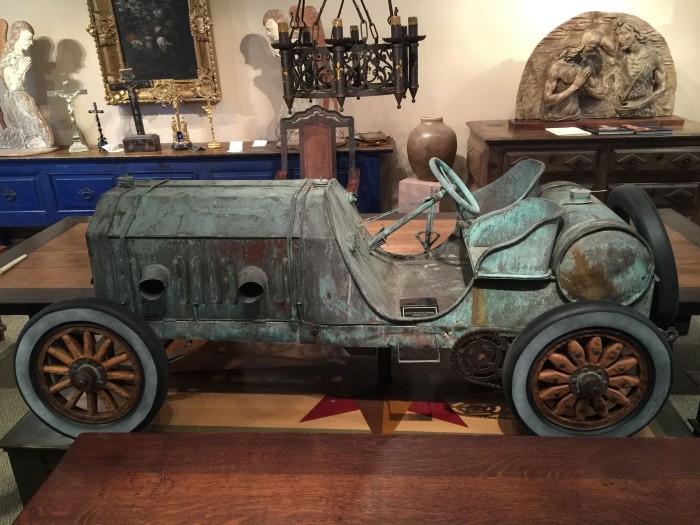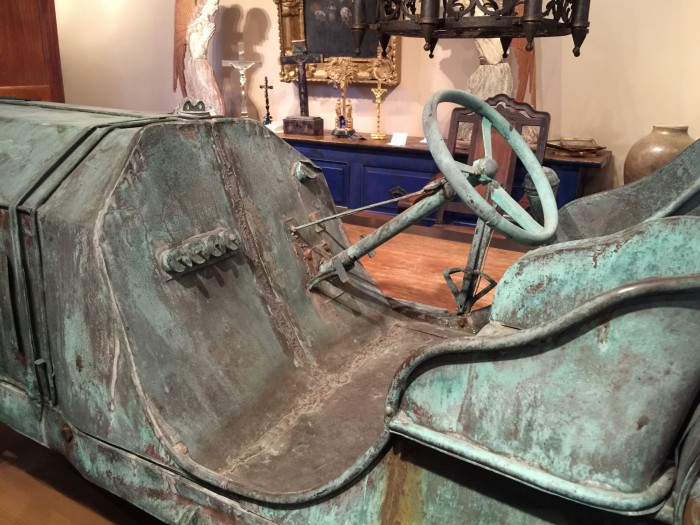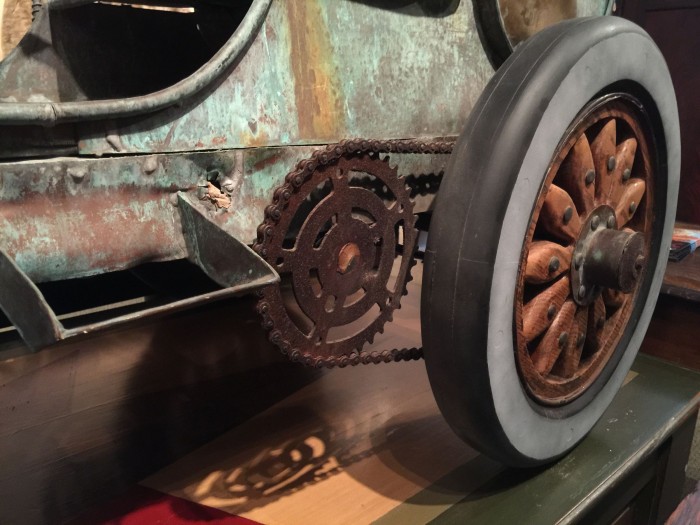Does this weathervane look familiar?
Posted on Oct 1, 2022 in Featured | 2 comments

If you began reading Hemmings in the 1950s or ’60s, there’s no doubt you’d recognize what car this interesting piece of sculpture represents. But as the hobby has shifted from the Ford Model T and Model A and what the AACA terms “Full Classics” into ’50s cruisers and muscle machines, some of the early history has become a bit obscure even to the most dedicated car folk. So when Managing Editor Dan Beaudry and I stumbled upon this piece in the back room of a local antique store here in Bennington, we recognized an excellent opportunity to discuss those pioneering days.
It’s a popular saying, often attributed to various automotive trailblazers, that “auto racing began five minutes after the second car was built,” but for over 10 years after brothers Charles and Frank Duryea first converted a $70 buggy to self-propulsion via a four-horsepower gasoline engine and drove their creation in the streets of what is now Chicopee, Massachusetts, there was no regular organized motorsport in the United States.
It took the efforts of one William Kissam Vanderbilt II (“Willie K.”), early auto enthusiast and heir to the fortune begun by Commodore Cornelius Vanderbilt, to organize the first automobile race in the U.S. Inspired by the Gordon Bennett Cup races held in Europe since 1900, in 1904 he laid out a course in Long Island, New York, and set forth to promote competition to U.S. auto manufacturers as a way to encourage race-bred developments to the automobile.

Despite initial public resistance, the first Vanderbilt Cup race was held October 8, 1904, but the Europeans, possibly due to their head start in developing race cars and related driving techniques, won the first two runnings. It was not until 1908 that an American car with an American driver would win an international race, and that race was the Vanderbilt Cup.
Like other early marques, Locomobile entered motor racing, first contesting the 1905 Gordon Bennett Cup with a 1,080-cu.in.-engined racer that ate its transmission after only two laps of the mountainous Auvergne circuit. That same year, Locomobile’s entry in the 1905 Vanderbilt Cup race took third, but a flat tire cost the company any shot at victory in 1906.
In 1908, however, Willie K. had upgraded the race course with the construction of parts of what became known as the Long Island Parkway, a public road that helped open up that previously rural area to development. Locomobile’s new driver, George Robertson, took the win in a Locomobile numbered 16 and the legend of “Old No. 16” was born.

Robertson was born in 1884. His father ran one of New York’s first big garages, and George was exposed to the best European and American marques from the beginning. In addition to Old No. 16, Robertson raced a Christie, a Hotchkiss and a Simplex. In 1910, he was made the captain of the German Benz racing team, but was injured while showing a newspaper reporter a race course, which led to his retirement from driving.
The Vanderbilt Cup races continued on Long Island until 1911 and then began to move to other venues around the country. The U.S. entry into World War I brought a halt to racing, and the Vanderbilt Cup races did not return in 1919.
As influential as the Vanderbilt Cup races were as a whole (many credit the “highboy roadster” look of the ’30s through the present as an imitation of the Vanderbilt Cup racers), arguably no aspect captured the public’s attention in the same way as Old No. 16.

As you may have guessed, it is Old No. 16 that this sculpture recreates. The story that was told to present owner Clifford Buisch of Four Corners East Antiques & Art (802-442-2612), when he purchased it in Palm Beach, Florida, was that it may have been commissioned by the Vanderbilts themselves (who often wintered in Palm Beach) to commemorate the race. Although it is scaled like a child’s pedal car, it currently sits on a swivel above a compass rose as though intended for use as a weathervane. Its patinated condition hints that it resided outside at some point.
The original Old No. 16 still exists in the collection of The Henry Ford in Dearborn, Michigan. Its technical details are fascinating, but we will leave them to others to relate. It has also passed through many owners before ending up at The Henry Ford, including the great automotive artist Peter Helck. Howard Kroplick, one of the most dedicated of Vanderbilt Cup historians, put us in touch with Helck’s son, Jerry.
Jerry viewed the Old No. 16 sculpture here and concluded that it is unlikely that the car was commissioned by the Vanderbilts or the Locomobile company (which was purchased by Billy Durant in 1922 and ceased operations seven years later), but is instead of 1950s or later vintage.
“It’s not really old,” Jerry says, “I don’t recall OLD 16 having a step originally; this looks like the one I made in the 1950s.”

Indeed, review of photos at the time it was raced do not show the step in question. Nevertheless, we think it’s a neat piece of automotive art that must have some interesting history of its own, given its large size and impressive detail. As Jerry notes, the artist “did get some details absolutely correct, e.g., the distinctive design of the radiator and oil tank caps.”
As for Robertson, in 1921, he served as Duesenberg’s team manager at the French Grand Prix, where they won. He was later vice president and general manager of Roosevelt Raceway on Long Island, which hosted a revived Vanderbilt Cup in 1936 and 1937.





Having been an antiques dealer for 50 years AND a lifelong car nut let me offer these comments:
1) It is NOT a weather vane – they are virtually always flat or near flat for the simple purpose of catching the wind.
2) Mounting sculpture on a post (even a rotating one) is not only not uncommon it is the standard practice for 3 dimensional folk art.
3) I would offer that the “step” mentioned might well actually be the shelf for the spare gas can Old No 16 carried.
4) A question – does it actually bear a number on the grill? Old No 16 held a huge place in the American Folk Consciousness in the pre-WWI so it’s not unexpected to see a tribute on this level – although it could have been an actual commission.
5) Although it was found in Palm Beach – the extreme quality of the work would seem to indicate it was done by a master craftsman who had a whole free winter available to him – i.e. Maine or Minnesota, etc. (Just my thought)
FWIW, there have been numerous period-constructed full-3D sculpted weathervanes, such as of steam locomotives. There are also numerous present-day weathervane sculptures presented online making it difficult to find pictures and info on the old ones. 🙁